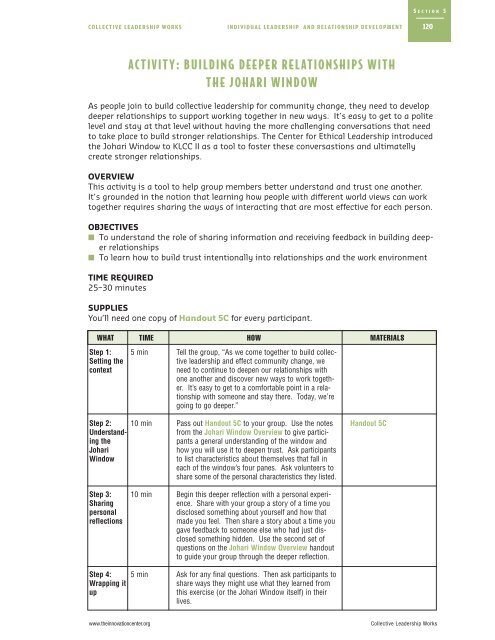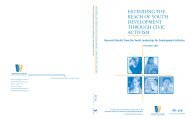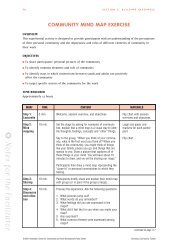activity: building deeper relationships with the johari window
activity: building deeper relationships with the johari window
activity: building deeper relationships with the johari window
You also want an ePaper? Increase the reach of your titles
YUMPU automatically turns print PDFs into web optimized ePapers that Google loves.
S E C T I O N 5<br />
C O L L E C T I V E L E A D E R S H I P W O R K S I N D I V I D U A L L E A D E R S H I P A N D R E L AT I O N S H I P D E V E L O P M E N T 120<br />
A C T I V I T Y : B U I L D I N G D E E P E R R E L AT I O N S H I P S W I T H<br />
T H E J O H A R I W I N D O W<br />
As people join to build collective leadership for community change, <strong>the</strong>y need to develop<br />
<strong>deeper</strong> <strong>relationships</strong> to support working toge<strong>the</strong>r in new ways. It’s easy to get to a polite<br />
level and stay at that level <strong>with</strong>out having <strong>the</strong> more challenging conversations that need<br />
to take place to build stronger <strong>relationships</strong>. The Center for Ethical Leadership introduced<br />
<strong>the</strong> Johari Window to KLCC II as a tool to foster <strong>the</strong>se conversastions and ultimatelly<br />
create stronger <strong>relationships</strong>.<br />
OVERVIEW<br />
This <strong>activity</strong> is a tool to help group members better understand and trust one ano<strong>the</strong>r.<br />
It’s grounded in <strong>the</strong> notion that learning how people <strong>with</strong> different world views can work<br />
toge<strong>the</strong>r requires sharing <strong>the</strong> ways of interacting that are most effective for each person.<br />
OBJECTIVES<br />
■ To understand <strong>the</strong> role of sharing information and receiving feedback in <strong>building</strong> <strong>deeper</strong><br />
<strong>relationships</strong><br />
■ To learn how to build trust intentionally into <strong>relationships</strong> and <strong>the</strong> work environment<br />
TIME REQUIRED<br />
25–30 minutes<br />
SUPPLIES<br />
You’ll need one copy of Handout 5C for every participant.<br />
WHAT TIME HOW MATERIALS<br />
Step 1:<br />
Setting <strong>the</strong><br />
context<br />
5 min<br />
Tell <strong>the</strong> group, “As we come toge<strong>the</strong>r to build collective<br />
leadership and effect community change, we<br />
need to continue to deepen our <strong>relationships</strong> <strong>with</strong><br />
one ano<strong>the</strong>r and discover new ways to work toge<strong>the</strong>r.<br />
It’s easy to get to a comfortable point in a relationship<br />
<strong>with</strong> someone and stay <strong>the</strong>re. Today, we’re<br />
going to go <strong>deeper</strong>.”<br />
Step 2:<br />
Understanding<br />
<strong>the</strong><br />
Johari<br />
Window<br />
10 min<br />
Pass out Handout 5C to your group. Use <strong>the</strong> notes<br />
from <strong>the</strong> Johari Window Overview to give participants<br />
a general understanding of <strong>the</strong> <strong>window</strong> and<br />
how you will use it to deepen trust. Ask participants<br />
to list characteristics about <strong>the</strong>mselves that fall in<br />
each of <strong>the</strong> <strong>window</strong>’s four panes. Ask volunteers to<br />
share some of <strong>the</strong> personal characteristics <strong>the</strong>y listed.<br />
Handout 5C<br />
Step 3:<br />
Sharing<br />
personal<br />
reflections<br />
10 min<br />
Begin this <strong>deeper</strong> reflection <strong>with</strong> a personal experience.<br />
Share <strong>with</strong> your group a story of a time you<br />
disclosed something about yourself and how that<br />
made you feel. Then share a story about a time you<br />
gave feedback to someone else who had just disclosed<br />
something hidden. Use <strong>the</strong> second set of<br />
questions on <strong>the</strong> Johari Window Overview handout<br />
to guide your group through <strong>the</strong> <strong>deeper</strong> reflection.<br />
Step 4:<br />
Wrapping it<br />
up<br />
5 min<br />
Ask for any final questions. Then ask participants to<br />
share ways <strong>the</strong>y might use what <strong>the</strong>y learned from<br />
this exercise (or <strong>the</strong> Johari Window itself) in <strong>the</strong>ir<br />
lives.<br />
www.<strong>the</strong>innovationcenter.org<br />
Collective Leadership Works
S E C T I O N 5<br />
C O L L E C T I V E L E A D E R S H I P W O R K S I N D I V I D U A L L E A D E R S H I P A N D R E L AT I O N S H I P D E V E L O P M E N T 121<br />
J O H A R I W I N D O W O V E R V I E W<br />
The Johari Window, named for its inventors, Joseph Luft and Harry Ingham, is one of <strong>the</strong><br />
most useful models for describing <strong>the</strong> creation of trust in human interaction.<br />
A four-paned “<strong>window</strong>” divides personal awareness into four types: open, hidden, blind<br />
and unknown. The lines dividing <strong>the</strong>se four panes are like <strong>window</strong> shades – <strong>the</strong>y can<br />
move as an interaction progresses. We build trust by opening our personal shades to<br />
o<strong>the</strong>rs so that we become an open <strong>window</strong>.<br />
(Adapted from Of Human Interaction, by Joseph Luft. Mayfield Publishing Company, 1969.)<br />
First Set of Questions<br />
1. Open. Things we know about ourselves and o<strong>the</strong>rs know about us. What are some<br />
things that would be in this <strong>window</strong> (e.g., how tall we are, hairstyle, whe<strong>the</strong>r or not<br />
we wear glasses)?<br />
2. Hidden. Things we know about ourselves and o<strong>the</strong>rs don’t know. What are some<br />
examples here (e.g., belief in religion, political leanings, fears, dreams)? When we<br />
open this <strong>window</strong> to share something about ourselves, we invite o<strong>the</strong>rs in. Disclosure<br />
builds trust.<br />
3. Blind. Things we don’t know about ourselves but o<strong>the</strong>rs do. What are some examples<br />
(e.g., at a light level, you have spinach in your teeth; at a <strong>deeper</strong> level, you talk<br />
too much at meetings, or you have a real gift for making people feel comfortable)?<br />
When you LET someone open this <strong>window</strong> on you, you will create trust between<br />
yourself and that person. You decide when, where, how, and how often you want to<br />
receive this FEEDBACK.When you want to open this <strong>window</strong> on someone else and give<br />
Feedback, ask permission first – don’t just pounce; that destroys trust. Opening this<br />
<strong>window</strong> requires compassion and kindness.<br />
4. Unknown. Things we don’t know and you don’t know ei<strong>the</strong>r. This is <strong>the</strong> area of<br />
mutual discovery, collaboration, and surprise – “fortuitous collisions.” The future is<br />
in this <strong>window</strong>. This is what we will discover in one ano<strong>the</strong>r and ourselves by interacting<br />
and <strong>building</strong> <strong>relationships</strong>.<br />
Second Set of Questions<br />
1. Think of someone in our group that you don’t know well or <strong>with</strong> whom you’d like to<br />
build a <strong>deeper</strong> and stronger relationship. What is something in your “hidden” <strong>window</strong><br />
that you’re willing to share to build trust <strong>with</strong> that person? Or to help members of<br />
your group work better toge<strong>the</strong>r, what are some things you might disclose to <strong>the</strong>m?<br />
Make a commitment to yourself to have this meeting in <strong>the</strong> next week.<br />
2. What feedback would you like to give, if this person were open to it? How will you<br />
phrase your request to give feedback? How will you have <strong>the</strong> person’s best self in<br />
mind so that you don’t damage your relationship? Examples of how to open <strong>the</strong><br />
conversation are: “I notice in meetings that you… I approach discussions in a<br />
different way… I wonder how we can find a way to be on <strong>the</strong> same page.” Make a<br />
commitment to invite this person to meet <strong>with</strong> you in <strong>the</strong> next week.<br />
3. What is some feedback about yourself that you’d like to have? From whom do you<br />
want it? Make a commitment to have this conversation.<br />
www.<strong>the</strong>innovationcenter.org<br />
Collective Leadership Works
S E C T I O N 5<br />
C O L L E C T I V E L E A D E R S H I P W O R K S I N D I V I D U A L L E A D E R S H I P A N D R E L AT I O N S H I P D E V E L O P M E N T 122<br />
H A N D O U T 5 C : T H E J O H A R I W I N D O W<br />
KNOWN TO SELF<br />
NOT KNOWN TO SELF<br />
NOT KNOWN TO OTHERS KNOWN TO OTHERS<br />
OPEN<br />
HIDDEN<br />
BLIND<br />
UNKNOWN<br />
<br />
Handout 5C<br />
www.<strong>the</strong>innovationcenter.org<br />
Collective Leadership Works










